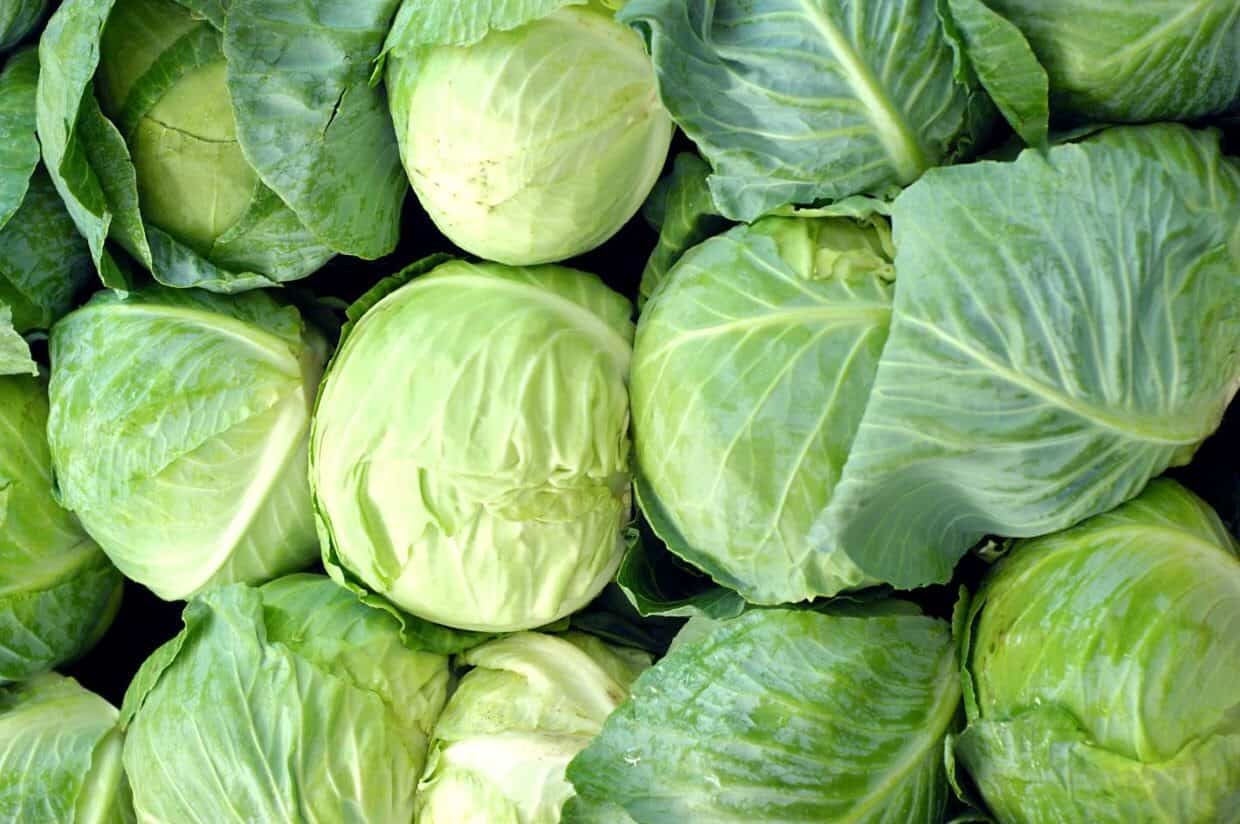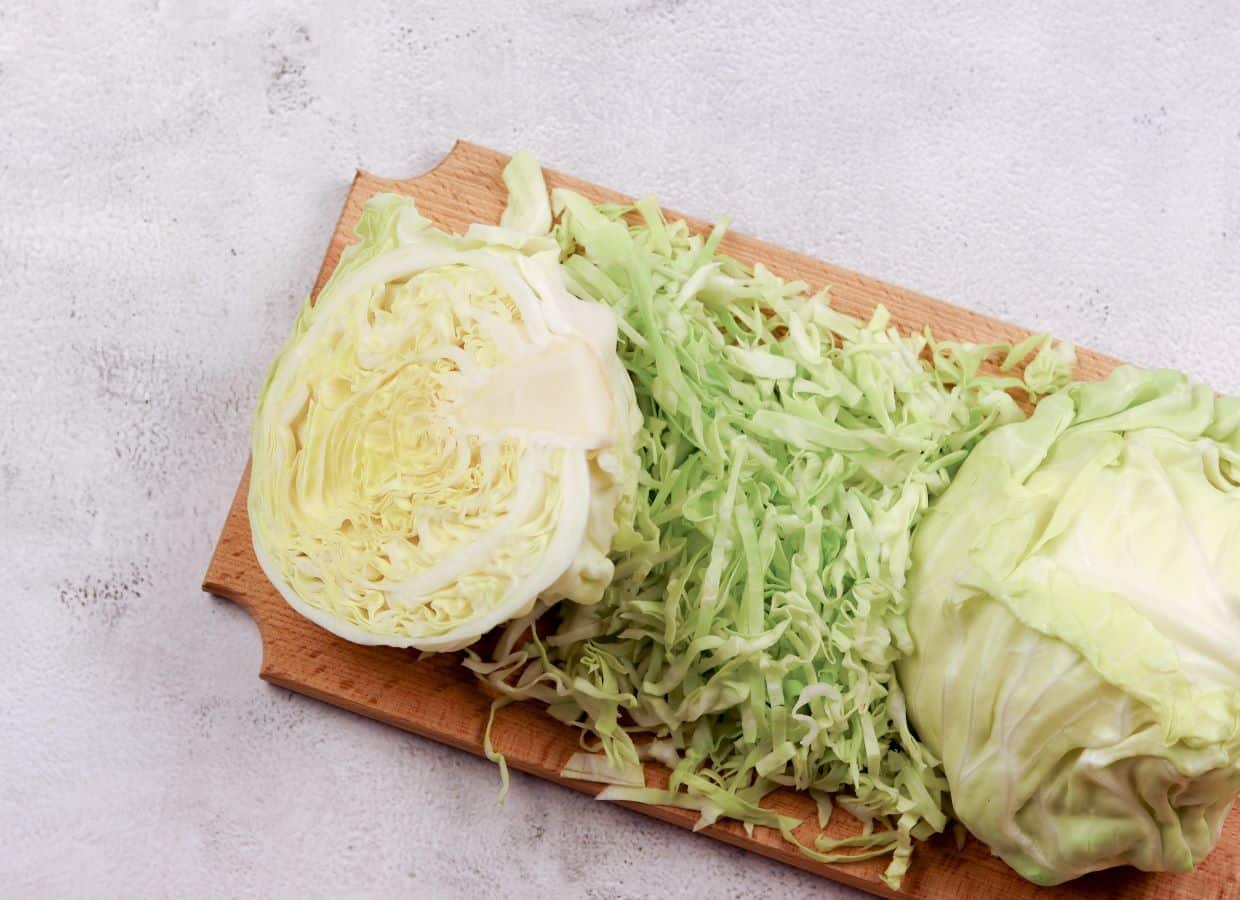Have you wondered, “Can you freeze cabbage?” after struggling to use up a whole head before it starts to wilt? You absolutely can freeze cabbage; the steps are straightforward, and this guide will show you how to do it right.

Benefits of freezing vegetables
Freezing vegetables is a valuable preservation method that offers several benefits.
Freezing them preserves freshness, nutrition and natural flavors, allowing fresh vegetables to be enjoyed year-round.
Additionally, it minimizes food waste and is cost-effective, allowing bulk purchases during lower-priced seasons.
Freezing vegetables like cabbage is convenient and allows you to use them later in recipes, like cabbage and sausage or fried cabbage and bacon.

How to freeze cabbage
Freezing cabbage is a great way to preserve its freshness and nutritional value for an extended period.
Here’s a step-by-step guide on how to do it:
- Clean the cabbage: Start by thoroughly washing the cabbage under cool, running water. Remove any outer leaves that might be damaged or wilted.
- Chop, shred or separate leaves from the cabbage: Decide how you want to use the frozen cabbage later. You can either chop it into bite-sized pieces or shred it for coleslaw or stir-fry recipes. You can also choose to separate the cabbage leaves from each other.
- Blanch the cabbage: Blanching is a crucial step to stop enzyme activity that can cause loss of color, flavor and nutrients during freezing. Bring a large pot of water to a boil and blanch the cabbage for one to two minutes, depending on the size of the pieces.
- Shock in ice water: Immediately transfer the blanched cabbage into a bowl of ice water to halt the cooking process. This process will help retain its crispness and color.
- Drain and dry: After shocking, drain the cabbage thoroughly and pat it dry with paper towels to remove excess moisture.
- Pack for freezing: Divide the cabbage into portions that you will likely use in one go. Use airtight freezer bags or containers and remove as much air as possible before sealing.
- Label and date: Label the storage bags or containers with the date of freezing to help keep track of their freshness.
“When I have leftover cabbage, I cut it into large chunks or quarters and blanch it in a salty hot water bath for a minute. Then, I transfer it to a bowl of cold water. Drain the cabbage and then let it dry on a clean towel. Before freezing it, I like to shred the cabbage into small pieces so it’s ready to add to stir-fries, soups or casseroles. Finally, I store the dried cabbage in freezer bags.”
— Jere’ Cassidy, One Hot Oven
FDL’S 75 Best Bites

Our cookbook with 75 tasty recipes will be your go-to kitchen companion for easy dinners with ad-free recipes right at your fingertips. Crafted by experienced chefs and recipe developers, this collection offers a treasure trove of tried-and-true dishes that make mealtime a breeze.
Get the Recipe: FDL’S 75 Best Bites
Can you freeze cabbage without blanching?
Yes, you can freeze cabbage without blanching, but blanching is recommended as it helps maintain its color and flavor while freezing. Blanching also stops enzyme activity that can lead to the breakdown of the cabbage over time.
Skipping the blanching process minimizes the time needed to freeze your cabbage, which is a plus.
If you choose to freeze cabbage without blanching, keep in mind that there may be changes in color, texture and taste compared to blanched frozen cabbage.
To freeze cabbage without blanching, follow these steps:
- Clean the cabbage: Wash the cabbage thoroughly under cool, running water and remove any damaged or wilted outer leaves.
- Chop or shred the cabbage: Decide how you want to use the frozen cabbage later and chop it into bite-sized pieces or shred it.
- Dry the cabbage: Use a paper towel to pat the cabbage dry and remove any excess moisture. Excess moisture can lead to freezer burn and affect the quality of the frozen cabbage.
- Pack for freezing: Divide the cabbage into portions you will likely use in one go. Use airtight freezer bags or containers and remove as much air as possible before sealing.
- Label and date: Label the bags or containers with the freezing date to help keep track of their freshness.
How long can you freeze raw cabbage?
When stored at 0 F or below, frozen cabbage can retain its quality for about eight to 12 months. Though, for the best taste and texture, it’s recommended to use it within six to nine months. After this time, while it may still be safe to eat, the quality will decrease.
How long can you freeze cooked cabbage?
Cooked cabbage can maintain its quality for about two to three months when stored in the freezer.
Once cooked, allow it to cool to room temperature, then follow the same packing and freezing steps as mentioned earlier for fresh cabbage.

Final thoughts
Freezing cabbage is a simple and effective method to preserve its freshness and nutritional value for an extended period.
You can successfully freeze cabbage with the easy-to-follow steps outlined in this guide. Whether you choose to blanch the cabbage or freeze it without blanching, both methods offer advantages. Blanching helps maintain the cabbage’s color, flavor and texture, while freezing without blanching provides a quicker process with some potential changes in the final result.
So, the next time you wonder, “Can you freeze cabbage?” you can confidently do it right.
Sara Nelson is the food blogger behind Real Balanced, a site that shares easy and balanced recipes. Since 2017, she has shared delicious, nutritious and allergy-friendly recipes with thousands of blog readers and social media followers. Sara lives in Wisconsin with her husband, two children and their dog.